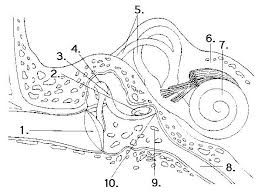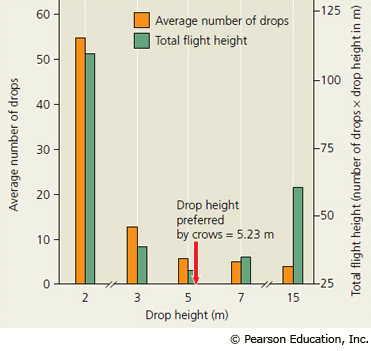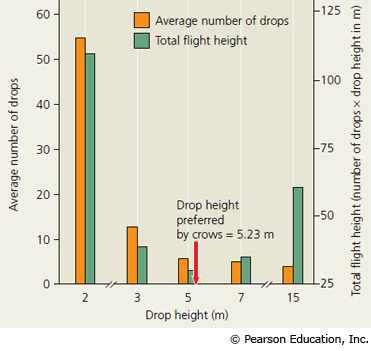.In the essay “The fossil Record: Seventh-Day Adventist Perspective”, H. Thomas goodwin
- Discusses Seventh-Day Adventist approaches to the fossil record and its interpretations
- Considers what fossils indicate about the diversity of life in the past
- Summarizes what science has learned about the sequence of life forms in the fossil record
- Suggest possibilities for Adventist study of the fossil record
Does all of the above
A behavior that not only includes eating, but also any mechanism to recognize,search and capture food is called
Foraging behavior
A rod exposed to light will
Undergo a graded hyperpolarization that will decrease its release of glutamate
Animals that help other animals of the same species are expected to
Be genetically related to the other animals
The geologic column is divided into
eras, periods, and epochs
The muscle of a recently deceased human can remain in a contracted state (rigor mortis) for several hours. This is dues to the lack of
ATP needed to break the actin-myosin bonds
Behavior that appears to decrease individual fitness but increases the fitness of others
Altruism
If we understand science to be an empirical-derived truth, then we understand that it is subjected to change and it is subjective
True
A type of learning that occurs only during a brief period of early life and results in a behavior that is difficult to modify through later experiences is called
Imprinting
Karl von Frisch demonstrated that European honeybees communicate the location of a distant food source by
Performing a long, straight run during a waggle dance
Statocysts contain cells that are
Mechanoreceptrors which function in orientation to gravity
Which statement about natural selection is most correct
Well-adapted individuals leave more offspring, and thus contribute more to the next generation’s gene pool, than do poorly adapted individuals
Skeletal muscle contraction begins when calcium ions bind to
Troponin
Which of the following is NOT considered one of Darwin’s observations
natural selection leads to speciation
A trend toward the decrease in the size of plants on the slopes of mountains as altitudes increase in an example of
A cline
Darwin’s mechanism of natural selection required long time spans in order to modify species. From whom did Darwin get the concept of Earth’s ancient age
Charles Lyell
If the frequency of a particular allele that is present in a small, isolated population of alpine plants decreases due to a landslide which leaves an even smaller remnant of surviving plants bearing this allele. This situation best describes
A bottleneck event
Sensory transduction of light/dark information in the vertebrate retina is accomplished by
Rods and cones
The movement of people on Earth has a steadily increased overtime. This altered the course of human evolution by increasing
Gene flow
The contribution an individual makes to the gene pool of the next generation, relative to the contribution of other individuals is known as
relative fitness
Which of the following statements summarizes natural selection
It is the differential success in reproduction that results in certain alleles being passed on in greater portions
A certain species of land snail exists as either a cream color or a solid brown color. Intermediate individuals are relatively rare. Which of the following terms best describes this?
Disruptive selection
Immediately after putting on a shirt, your skin may feel itchy. However, the perception soon fades away due to
Sensory adaptation
Cumulative changes in a population over time
Biological Evolution
Sickle-cell anemia is an interesting genetic disease. Normal homozygous individuals (SS) have normal blood cells that are easily infected with the malarial parasite. Thus, many of these individuals become very ill from the parasite and many die. Individuals homozygous for the sickle-cell trait (ss) have red blood cells that readily collapse when deoxygenated. Although malaria cannot grow in these red blood cells, individuals often die because of the genetic defect. However, individuals with the heterozygous condition (Ss) have some sickling of the red blood cells, but generally not enough to cause mortality. In addition, malaria cannot survive well within these “partially defective” red blood cells. Thus, heterozygous tend to survive better than either of the homozygous conditions. If 9% of an African population is born with a severe form of sickle-cell anemia (ss), what percentage of the population will be more resistant to malaria because the are heterozygous (Ss) for the sickle-cell gene?
42%
The presence of altruistic behavior in animals is most likely due to kin selection, a theory maintaining that
Genes enhance survival of copies of themselves by directing organisms to assist others who share those genes
You are a biologist with a new assigned project. You have been asked to report on the underlying control mechanism of what initiates migratory behavior. Your first step is to design an experiment that determines whether such behavior is largely under genetic control. Which of the following would most closely describe your experimental design?
Perform matings with birds from different populations that have different migratory habits. Rear the offspring in the absence of their parents and observe offspring migratory behaviors.
In Darwin’s thinking, the more closely related two different organisms are, the
More recently they shared a common ancestor
Female spotted sandpipers aggressively court males and, after mating, leave the clutch of young for the male to incubate. This sequence may be repeated several times with different males until no available males remain, forcing the female to incubate her last clutch. Which of the following terms best describes this behavior?
Polyandry
. Which of the following is the correct sequence that describes the excitation and contraction of a skeletal muscle fiber?
- Tropomyosin shifts and unblocks the cross-bridge binding site.
- Calcium is released and binds to the troponin complex.
- Transverse tubules depolarize the sarcoplasmic reticulum.
- The thin filaments are ratcheted across the thick filaments by the heads of the myosin molecules using energy from ATP
- An action potential in a motor neuron causes the axon to release acetylcholine, which depolarizes the muscle cell membrane.
5->3->2->1->4
A geologist that proposed uniformitarianism and that influenced Darwin’s thoughts about life
Lyell
Tastes and smells are distinct kinds of environmental information that
Neural projections from taste receptors reach different parts of the brain than the neural projections from olfactory receptors.
During a study session about evolution, one of your fellow student remarks, “the giraffe stretched its neck while reaching for higher leaves; its offspring inherited longer necks as a result.” Which statement is most likely to be helpful in correcting this student’s misconception?
Characteristics acquired during an organism's life are generally not passes on through genes

The sense of head motion begins with sensory transduction by the structures at which number(s)?
5
Vibrations of the tympanic membrane to the oval window are transmitted by the structures at which numbers?
3 and 4
Which of the following is a limitation to science as discussed by H. Thomas Goodwin in his essay “Science & Christian Faith: Honest Friends”?
A.Science is a human endeavor, and because humans are finite and have limitations, therefore those limitations are transferred to science
B.The scope of the subject of science is a limit. Reality goes beyond the empirical universe.
A and B only
The concept that science is the source of all truth is proposed by
Materialism
The contraction of skeletal muscle is based on
Myosin cross-bridges binding to actin and then flexing
Catastrophism, meaning the regular occurrence of geological or meteorological disturbances (catastrophes), was Cuvier’s attempt to explain the existence of
the fossil record
The calcium ions released into the cytosol during excitation of skeletal muscle bind to
troponin
Listed below are several examples of types of animal behavior. Match the correct term (A-E) to each example in the following questions
A.Operant Conditioning
B.Agonistic Behavior
C.Innate Behavior
D.Imprinting
E. Altruistic behavior
Through trial and error, a rat learns to run a maze without mistakes to receive a food reward
A
Listed below are several examples of types of animal behavior. Match the correct term (A-E) to each example in the following questions
A.Operant Conditioning
B.Agonistic Behavior
C.Innate Behavior
D.Imprinting
E. Altruistic behavior
A human baby performs a suckling behavior perfectly when it is put in the presence of the nipple of its mother’s breast.
C
Listed below are several examples of types of animal behavior. Match the correct term (A-E) to each example in the following questions
A.Operant Conditioning
B.Agonistic Behavior
C.Innate Behavior
D.Imprinting
E. Altruistic behavior
A mother goat can recognize its own kid by smell.
D
Listed below are several examples of types of animal behavior. Match the correct term (A-E) to each example in the following questions
A.Operant Conditioning
B.Agonistic Behavior
C.Innate Behavior
D.Imprinting
E. Altruistic behavior
Upon observing a golden eagle flying overhead, a sentry prairie dog gives a warning call to other foraging members of the prairie dog community.
B

On islands off British Columbia, Canada, Northwestern crows (Corvus caurinus) search rocky tide pools for sea snails called whelks. After spotting a whelk, the crow picks it up in its beak, flies upward, and drops the whelk onto the rocks. If the drop is successful, the shell breaks and the crow can dine on the whelk’s soft parts. If not, the crow flies up and drops the whelk again and again until the shell breaks.What determines how high the crow flies? If energetic considerations dominated selection for the crow’s foraging behavior, the average drop height might reflect a trade-off between the cost of flying higher and the benefit of more frequent success. In this exercise, you’ll test how well this optimal foraging model predicts the average drop height observed in nature.The height of drops made by crows in the wild was measured by referring to a marked pole erected nearby. In the test, the crow’s behavior was simulated using a device that dropped a whelk onto the rocks from a fixed platform. The average number of drops required to break whelks from various platform heights was recorded and averaged over many trials with the device.Combining the data for each platform height, total “flight” height was calculated by multiplying the drop height by the average number of drops required.
Researchers observed that the crows only gather and drop the largest whelks. Why might cause crows to favor larger whelks?
Large whelks might offer more calories than small whelks

On islands off British Columbia, Canada, Northwestern crows (Corvus caurinus) search rocky tide pools for sea snails called whelks. After spotting a whelk, the crow picks it up in its beak, flies upward, and drops the whelk onto the rocks. If the drop is successful, the shell breaks and the crow can dine on the whelk’s soft parts. If not, the crow flies up and drops the whelk again and again until the shell breaks.What determines how high the crow flies? If energetic considerations dominated selection for the crow’s foraging behavior, the average drop height might reflect a trade-off between the cost of flying higher and the benefit of more frequent success. In this exercise, you’ll test how well this optimal foraging model predicts the average drop height observed in nature.The height of drops made by crows in the wild was measured by referring to a marked pole erected nearby. In the test, the crow’s behavior was simulated using a device that dropped a whelk onto the rocks from a fixed platform. The average number of drops required to break whelks from various platform heights was recorded and averaged over many trials with the device.Combining the data for each platform height, total “flight” height was calculated by multiplying the drop height by the average number of drops required.
It turns out that the probability of a whelk breaking is the same for a whelk dropped for the first time as for an unbroken whelk dropped several times previously. If the probability of breaking instead increased with each additional drop, what change might you predict in the crows’ behavior?
The crows would fly to lower heights in subsequent drops
The ability to taste PTC is due to a single dominant allele “T”. You sampled 215 individuals in biology and determined that 150 could detect the bitter taste of PTC and 65 could not. The genotypic frequency of heterozygotes is
0.49
Plants in “Mediterranean” ecosystems have similar adaptations for surviving hot dry summers and fire. Given that these ecosystems are presently found in southern Europe. California, Chile, South Africa, and Southern Australia, which of the following best explains the origin of these adaptations?
Although these plants likely do not share a recent ancestor, they have been subjected to the same selective pressures
The transduction of sound waves into action potentials occurs
When hair cells are bent against the tectorial membrane, causing them to depolarize and release neurotransmitters that stimulates sensory neurons
If calcium ions are not present in the sarcomere, muscle contraction cannot occur because
Myosin cannot bind to actin